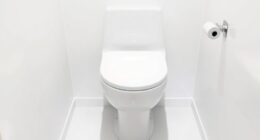By sitting on a public toilet seat, we are exposing ourselves to various bacteria. Toilet seat covers are specifically designed to act as a barrier against these germs, providing protection during bathroom use.
But do they really work? In this article, we will explore the effectiveness of toilet seat covers, the risks associated with their use, and provide alternative solutions.
So, let’s dive in and uncover the truth about toilet seat covers!
Key Takeaways
- Scientific evidence supporting the effectiveness of toilet seat covers is limited
- The actual effectiveness of toilet seat covers in preventing the spread of germs and bacteria is uncertain
- Toilet seat covers may provide a psychological benefit to users by reducing anxiety and increasing comfort
- Proper hand hygiene, such as washing hands with soap and water, is the most effective way to prevent the transmission of germs in the restroom.
How Toilet Seat Covers Work
Toilet seat covers work by providing a protective barrier between the user and the potentially unclean surface of the toilet seat. These covers are typically made of thin paper or plastic material and are designed to fit over the seat, preventing direct contact.

One of the main advantages of using toilet seat covers is that they can help reduce the risk of coming into contact with germs, bacteria, and viruses that may be present on the seat. This can provide peace of mind for individuals concerned about hygiene in public restrooms.
However, it’s important to note that there are also some disadvantages to using toilet seat covers. They can be inconvenient to use, as they may tear or not fit properly. Additionally, some studies suggest that the risk of contracting an illness from a toilet seat is relatively low compared to other surfaces.
Transitioning into the subsequent section about the effectiveness of toilet seat covers, it’s crucial to evaluate the scientific evidence behind their claims.
Effectiveness of Toilet Seat Covers
Moving on to the effectiveness of toilet seat covers, we can evaluate whether they truly provide the intended protection against germs and bacteria.

When it comes to hygiene concerns, toilet seat covers are often seen as a solution to prevent the transmission of germs from one user to another. However, studies have shown that toilet seat covers may not be as effective as we think. While they do act as a physical barrier, they may not fully protect against all types of bacteria and viruses.
Additionally, toilet seat covers can have a minimal environmental impact. Most toilet seat covers are made from biodegradable materials, such as paper, which can break down easily in landfills. However, the production and disposal of these covers still contribute to waste.
Therefore, it’s important to weigh the potential hygiene benefits against the environmental impact when considering the use of toilet seat covers.
Potential Risks of Using Toilet Seat Covers
As we delve into the potential risks of using toilet seat covers, it’s important to consider the limitations they pose in terms of providing comprehensive protection against germs and bacteria. While toilet seat covers may offer some level of protection, there are several factors to be aware of:

- Risks of bacterial contamination: Toilet seat covers may not fully cover the entire seat, leaving areas exposed to potential contamination. Additionally, bacteria can still be present on the cover itself, especially if it has been touched by multiple individuals.
- Environmental impact: Toilet seat covers are typically made from paper, which contributes to deforestation and waste production. Their single-use nature also adds to the overall environmental burden.
- Limited effectiveness: Toilet seat covers can’t completely eliminate the risk of bacterial transmission. They may provide a psychological sense of protection, but it’s important to maintain good hygiene practices such as handwashing.
Considering these factors, it’s worth exploring alternatives to toilet seat covers that may offer more comprehensive protection against germs and bacteria.
Alternatives to Toilet Seat Covers
There are several alternatives to using toilet seat covers that provide comprehensive protection against germs and bacteria. Two popular options are bidets and sanitizing wipes.
Bidets are fixtures that spray water to cleanse the genital and anal areas. They’re effective at removing bacteria and preventing the spread of germs. Bidet options range from standalone fixtures to toilet seat attachments, providing users with various choices.
On the other hand, sanitizing wipes are pre-moistened wipes that can be used to clean the toilet seat before use. They’re convenient and easy to carry, making them a practical option for individuals concerned about cleanliness.

Both bidets and sanitizing wipes offer alternatives to toilet seat covers and can effectively help maintain hygiene in the restroom.
Now, let’s explore the final verdict: do toilet seat covers really work?
Final Verdict: Do Toilet Seat Covers Really Work?
To address the question of whether toilet seat covers truly work, let’s delve into the evidence and examine their effectiveness in preventing the spread of germs and bacteria.
Here are the pros of using toilet seat covers:

- Provides a physical barrier between the user and the toilet seat, reducing direct contact with potentially contaminated surfaces.
- Offers peace of mind and a sense of cleanliness for individuals who are concerned about hygiene.
- Easy to use and readily available in most public restrooms.
Here are the cons of using toilet seat covers:
- Limited coverage may result in gaps or slippage, reducing the effectiveness of the cover.
- Some argue that toilet seat covers are unnecessary, as the risk of contracting an infection from a toilet seat is low.
- Environmental concerns arise due to the disposable nature of most toilet seat covers.
Scientific evidence supporting the use of toilet seat covers is limited. While they may provide a psychological benefit, their actual effectiveness in preventing the spread of germs and bacteria remains uncertain. It’s important to remember that proper hand hygiene is the most effective way to prevent the transmission of germs in the restroom.
Frequently Asked Questions
Are Toilet Seat Covers Disposable or Reusable?
Toilet seat covers can be either disposable or reusable. The effectiveness of these covers in preventing germs depends on their material and how they are used. It is important to follow proper hygiene practices regardless.
Can Toilet Seat Covers Prevent the Spread of Sexually Transmitted Infections?
Toilet seat covers are often believed to prevent the spread of bacteria and sexually transmitted infections. However, current scientific evidence suggests that they are not effective in doing so. It is important to rely on more reliable methods of protection.

How Often Should Toilet Seat Covers Be Changed?
How often should we change toilet seat covers? Proper toilet seat cover hygiene is crucial for preventing the spread of bacteria. Remember to dispose of used covers properly to maintain cleanliness in public restrooms.
Do Toilet Seat Covers Fit All Toilet Seats?
Toilet seat covers are popular alternatives to using toilet paper or hand towels. They provide a barrier between the user and the toilet seat, reducing the risk of contact with germs and bacteria. However, not all toilet seat covers fit every toilet seat.
Can Using Toilet Seat Covers Cause Skin Irritation or Allergies?
Using toilet seat covers can potentially cause skin irritation or allergies. It is important to consider personal hygiene and the effectiveness of toilet seat covers in preventing the spread of germs.
Conclusion
In conclusion, toilet seat covers provide a barrier between the user and the toilet seat, reducing the direct contact with germs and bacteria. However, their effectiveness in preventing infection is limited.

Like a thin veil over the seat, they offer some protection but aren’t foolproof. It’s important to practice good hygiene habits, such as washing hands thoroughly, to minimize the risk of bacterial transmission.










